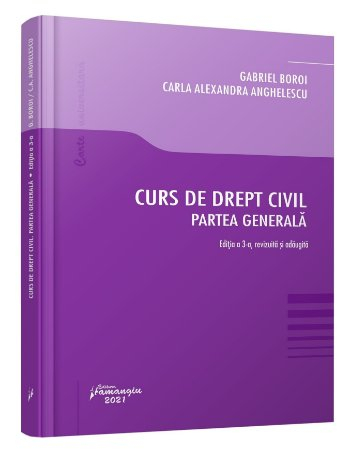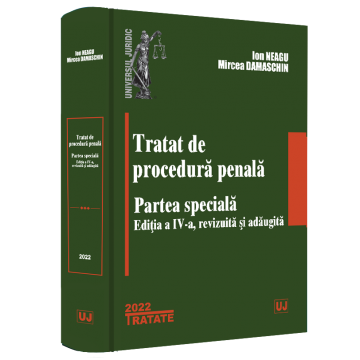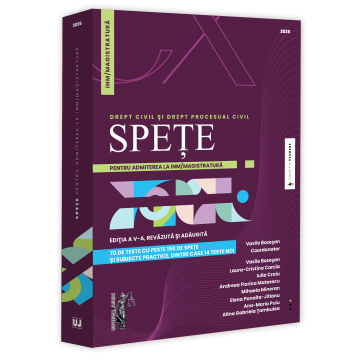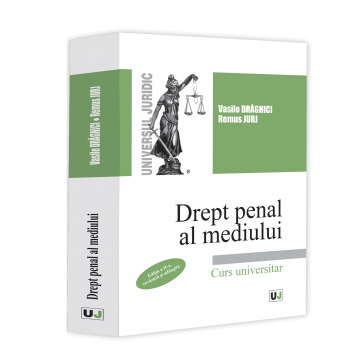Manuscript proposals: [email protected] / 0745 204 115 //// Tracking orders Individuals / Sales: 0745 200 357 / Orders Legal entities: 0721 722 783
ISBN: 978-606-28-1380-2
DOI: https://doi.org/10.5682/9786062813802
Publisher year: 2021
Edition: I
Pages: 150
Publisher: Editura Universitară
Author: Nicolae Ploeşteanu, Raul Miron
Product Code:
9786062813802
Do you need help?
0745 200 357
- Description
- Download (1)
- Authors
- Content
- More details
- Reviews (0)
A handbook is needed for any interested person to understand the main way in which the states of the world come to have the most varied legal connections, pursuing their interests and their own objectives on the basis of solidarity and context.
A textbook is needed to clarify in an uncomplicated but current manner all the stages in the life of an international treaty and, in particular, to clarify how it is generated by the interest of each of the Contracting States, in how it relates to the interests of future states parties and how it influences international life.
The textbook is written for students studying law or other specializations in the field of social sciences so that they can learn the basics. Even if very few students practice, attention to the interpretation of the treaties will be accompanied by important baggage necessary for a relevant analysis. This manual is dedicated to the university activity, training and evaluation of students.
The manual can be very easily used for the continuous training of specialists from different ministries who have departments with responsibilities in the field of international relations, because knowledge in this field is inherent in any task concerning the negotiation, analysis, conclusion of international treaties.
The authors preferred to give expression to those writings that are relevant in the field, without intending to attribute to the material any value of their own scientific research, whenever the conceptual statements and reasoning already expressed are clear and there is no need to reformulate them. For this reason and because the idea of the textbook is to serve the learning and training activity of students, no references are made using bibliographic notes but the bibliographic materials used are indicated at the end.
It is relevant that after this material were prepared from 2003 until now teams of students who have competed in international competitions in the field of public international law and have obtained good results, which confirms the quality of the exhibition.
People close to the authors have contributed to the elaboration or presentation of some texts and in a way many thoughts of gratitude are directed towards them. There is a possibility that some materials are already in the online space, because the current technological level exceeds any stage of classical communication, such as that through printed materials. In this situation, the authors assume their responsibility, without neglecting the good intentions of the previously published communications.
The handbook includes student assessment topics and a relevant translation of a case in which there are problems with the interpretation of expressions, namely the case of the dispute over navigation rights and other related rights between Costa Rica and Nicaragua settled by the International Court of Justice.
A textbook is needed to clarify in an uncomplicated but current manner all the stages in the life of an international treaty and, in particular, to clarify how it is generated by the interest of each of the Contracting States, in how it relates to the interests of future states parties and how it influences international life.
The textbook is written for students studying law or other specializations in the field of social sciences so that they can learn the basics. Even if very few students practice, attention to the interpretation of the treaties will be accompanied by important baggage necessary for a relevant analysis. This manual is dedicated to the university activity, training and evaluation of students.
The manual can be very easily used for the continuous training of specialists from different ministries who have departments with responsibilities in the field of international relations, because knowledge in this field is inherent in any task concerning the negotiation, analysis, conclusion of international treaties.
The authors preferred to give expression to those writings that are relevant in the field, without intending to attribute to the material any value of their own scientific research, whenever the conceptual statements and reasoning already expressed are clear and there is no need to reformulate them. For this reason and because the idea of the textbook is to serve the learning and training activity of students, no references are made using bibliographic notes but the bibliographic materials used are indicated at the end.
It is relevant that after this material were prepared from 2003 until now teams of students who have competed in international competitions in the field of public international law and have obtained good results, which confirms the quality of the exhibition.
People close to the authors have contributed to the elaboration or presentation of some texts and in a way many thoughts of gratitude are directed towards them. There is a possibility that some materials are already in the online space, because the current technological level exceeds any stage of classical communication, such as that through printed materials. In this situation, the authors assume their responsibility, without neglecting the good intentions of the previously published communications.
The handbook includes student assessment topics and a relevant translation of a case in which there are problems with the interpretation of expressions, namely the case of the dispute over navigation rights and other related rights between Costa Rica and Nicaragua settled by the International Court of Justice.
-
Treaty law
Download
NICOLAE PLOESTEANU
RAUL MIRON
RAUL MIRON
Why a Handbook on Treaty Law? / 7
INTRODUCTION / 9
I. FUNDAMENTAL CONCEPTS AND STRUCTURE / 11
1.1. What is a treaty? / 11
1.2. Vienna Convention / 14
1.2.1. The scope of the Vienna Convention (1969) / 15
1.2.2. Vienna Convention and International Customs Law / 15
II. STRUCTURE OF THE TREATY / 17
2.1. The role of the treaties / 17
2.2. Competence to conclude treaties / 17
2.3. Ways and stages of expressing consent to be bound by the treaty / 19
2.3.1. Signing / 20
2.3.2. Ratification / 21
2.3.3. Accession / 22
2.3.4. Acceptance and approval / 22
2.4. Invalidity of treaties / 23
2.5. Amending, amending and revising treaties / 25
2.6. Termination and suspension of the execution of treaties / 26
III. SCOPE OF THE LEGAL RIGHTS AND OBLIGATIONS OF THE TREATY / 27
3.1. The Pacta principle is servanda / 27
3.2. Treaties and third States / 28
IV. GENERAL PRINCIPLES OF INTERPRETATION / 30
4.1. General issues / 30
4.2. Practice / 33
4.3. Preparatory work / 35
4.4. Object and purpose of the treaty / 37
4.5. The principle of effectiveness / 37
4.6. Multilingual Treaties / 37
V. TREATY RESERVATIONS / 39
5.1. The Case of the Genocide Convention / 39
5.2. The regime of the Vienna Convention of 1969/40
5.3. The issue of reservations to human rights treaties / 42
5.4. Interpretative statements / 44
VI. TERMINATION OF TREATIES / 46
6.1. Presentation of all the causes of cessation and the practice in the matter / 46
6.2. Substantial violation / 46
6.3. Impossibility of execution / 48
6.4. Fundamental change of circumstances / 49
ARE YOU COMING. CONCLUSIONS / 51
VIII. EXAMINATION SUBJECTS / 52
IX. BIBLIOGRAPHY / 60
CASE REGARDING THE DISPUTE REGARDING NAVIGATION RIGHTS AND OTHER RELATED RIGHTS (COSTA RICA vs. NICARAGUA) INTERNATIONAL COURT OF JUSTICE JUDGMENT OF 13 JULY 2009/63
CONVENTION of 23 May 1969 on the law of treaties / 113
INTRODUCTION / 9
I. FUNDAMENTAL CONCEPTS AND STRUCTURE / 11
1.1. What is a treaty? / 11
1.2. Vienna Convention / 14
1.2.1. The scope of the Vienna Convention (1969) / 15
1.2.2. Vienna Convention and International Customs Law / 15
II. STRUCTURE OF THE TREATY / 17
2.1. The role of the treaties / 17
2.2. Competence to conclude treaties / 17
2.3. Ways and stages of expressing consent to be bound by the treaty / 19
2.3.1. Signing / 20
2.3.2. Ratification / 21
2.3.3. Accession / 22
2.3.4. Acceptance and approval / 22
2.4. Invalidity of treaties / 23
2.5. Amending, amending and revising treaties / 25
2.6. Termination and suspension of the execution of treaties / 26
III. SCOPE OF THE LEGAL RIGHTS AND OBLIGATIONS OF THE TREATY / 27
3.1. The Pacta principle is servanda / 27
3.2. Treaties and third States / 28
IV. GENERAL PRINCIPLES OF INTERPRETATION / 30
4.1. General issues / 30
4.2. Practice / 33
4.3. Preparatory work / 35
4.4. Object and purpose of the treaty / 37
4.5. The principle of effectiveness / 37
4.6. Multilingual Treaties / 37
V. TREATY RESERVATIONS / 39
5.1. The Case of the Genocide Convention / 39
5.2. The regime of the Vienna Convention of 1969/40
5.3. The issue of reservations to human rights treaties / 42
5.4. Interpretative statements / 44
VI. TERMINATION OF TREATIES / 46
6.1. Presentation of all the causes of cessation and the practice in the matter / 46
6.2. Substantial violation / 46
6.3. Impossibility of execution / 48
6.4. Fundamental change of circumstances / 49
ARE YOU COMING. CONCLUSIONS / 51
VIII. EXAMINATION SUBJECTS / 52
IX. BIBLIOGRAPHY / 60
CASE REGARDING THE DISPUTE REGARDING NAVIGATION RIGHTS AND OTHER RELATED RIGHTS (COSTA RICA vs. NICARAGUA) INTERNATIONAL COURT OF JUSTICE JUDGMENT OF 13 JULY 2009/63
CONVENTION of 23 May 1969 on the law of treaties / 113
The international treaty is a means of co-operation between states and an efficient and precise method of regulating relations between them. International treaties are of paramount importance in the conduct of international relations, and as a legal source their influence is constantly growing. It is essential in the study and application of the law of international treaties to take into account that the international treaty is a manifestation of sovereignty.
Their role in public international law is manifested under two main aspects: on the one hand, it contributes to the codification of law, and on the other hand it contributes to its progressive development. While codification leads to greater accuracy of regulations, progressive development leads, in principle, to an increase in the quality of international law, both vertically and horizontally. There are currently areas that are inconceivable in the absence of international treaties (such as human rights, international law, international investment and international trade, international transport and communications, cyber security, etc.). The codification of the law of treaties was accomplished by the 1969 Vienna Convention on the Law of Treaties, without exhausting all issues arising from the conclusion, execution, amendment or termination of international treaties. Knowledge of treaty law is essential for understanding how international relations and international law work (even if we are in a sphere of social relations in which the presence of the political factor is constant), but also for understanding the interdependencies between international law and domestic law. states. The role of treaty law is not limited to its contributions in relations between states, but on the contrary it is growing. The law of treaties has the vocation to regulate absolutely all the relations that take place between entities that have international capacity (international governmental organizations, peoples fighting for liberation), even if there are divergent opinions on these aspects. Indeed, sometimes the regulations of the law of treaties are only a normative loan without binding legal force.
The role of international treaties must not, at present, be reduced to the sphere of public international law. The role of international treaties in the modern period extends to the domestic law of states, even if the actual application depends on the constitutional system of each state. On domestic law, in principle, the international treaty can be manifested under the following aspects: to generate its uniformity by reference to the legal system of the other states parties; to confer on entities that normally do not have international status, specific capacities to act in the field of international relations.
The law of international treaties, as a legal discipline and subdivision of law, consists of the rules and procedure for the creation, application and termination of international treaties, including all moments of their existence. In other words, the law of treaties is a "law" of treaties. There is a distinction between this concept and the rules contained in the treaties and the meaning of the expression treaty law should not be confused with the rules contained in international treaties; the latter make up what is known as conventional international law, designating all the international legal rules that are expressed in international treaties. On the other hand, the law of treaties, although largely covered by the Vienna Convention on the Law of Treaties, its rules express general international law.
Their role in public international law is manifested under two main aspects: on the one hand, it contributes to the codification of law, and on the other hand it contributes to its progressive development. While codification leads to greater accuracy of regulations, progressive development leads, in principle, to an increase in the quality of international law, both vertically and horizontally. There are currently areas that are inconceivable in the absence of international treaties (such as human rights, international law, international investment and international trade, international transport and communications, cyber security, etc.). The codification of the law of treaties was accomplished by the 1969 Vienna Convention on the Law of Treaties, without exhausting all issues arising from the conclusion, execution, amendment or termination of international treaties. Knowledge of treaty law is essential for understanding how international relations and international law work (even if we are in a sphere of social relations in which the presence of the political factor is constant), but also for understanding the interdependencies between international law and domestic law. states. The role of treaty law is not limited to its contributions in relations between states, but on the contrary it is growing. The law of treaties has the vocation to regulate absolutely all the relations that take place between entities that have international capacity (international governmental organizations, peoples fighting for liberation), even if there are divergent opinions on these aspects. Indeed, sometimes the regulations of the law of treaties are only a normative loan without binding legal force.
The role of international treaties must not, at present, be reduced to the sphere of public international law. The role of international treaties in the modern period extends to the domestic law of states, even if the actual application depends on the constitutional system of each state. On domestic law, in principle, the international treaty can be manifested under the following aspects: to generate its uniformity by reference to the legal system of the other states parties; to confer on entities that normally do not have international status, specific capacities to act in the field of international relations.
The law of international treaties, as a legal discipline and subdivision of law, consists of the rules and procedure for the creation, application and termination of international treaties, including all moments of their existence. In other words, the law of treaties is a "law" of treaties. There is a distinction between this concept and the rules contained in the treaties and the meaning of the expression treaty law should not be confused with the rules contained in international treaties; the latter make up what is known as conventional international law, designating all the international legal rules that are expressed in international treaties. On the other hand, the law of treaties, although largely covered by the Vienna Convention on the Law of Treaties, its rules express general international law.
If you want to express your opinion about this product you can add a review.
write a review

6359.png)
![Treaty law [1] Treaty law [1]](https://gomagcdn.ro/domains/editurauniversitara.ro/files/product/large/plowstenu-miron_drept-tratat-intrnat_bt-4392-7960.jpg)














